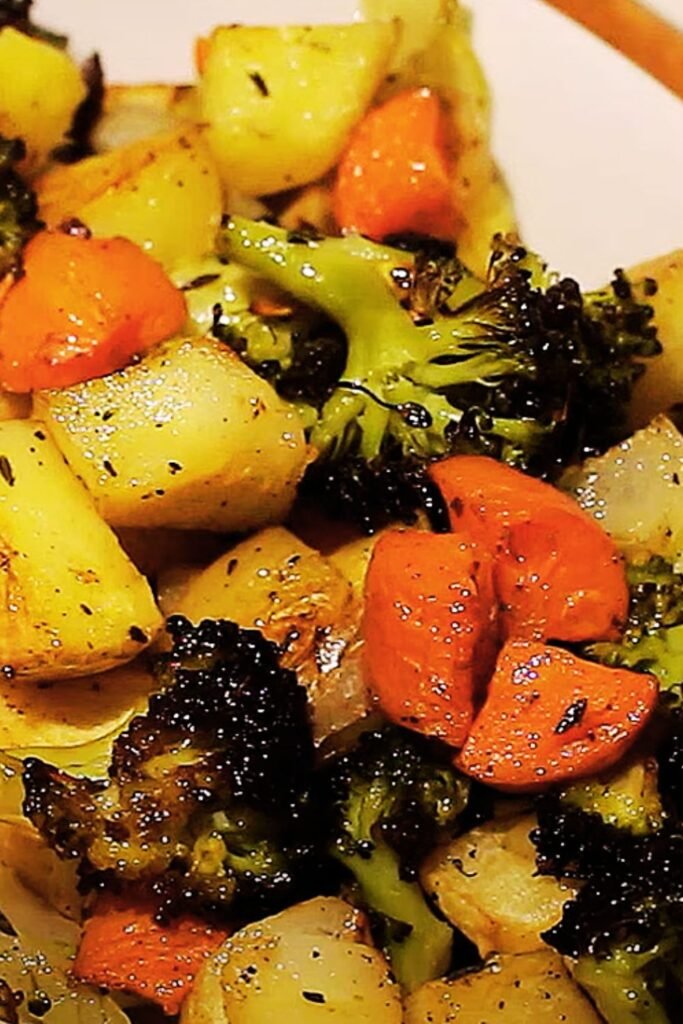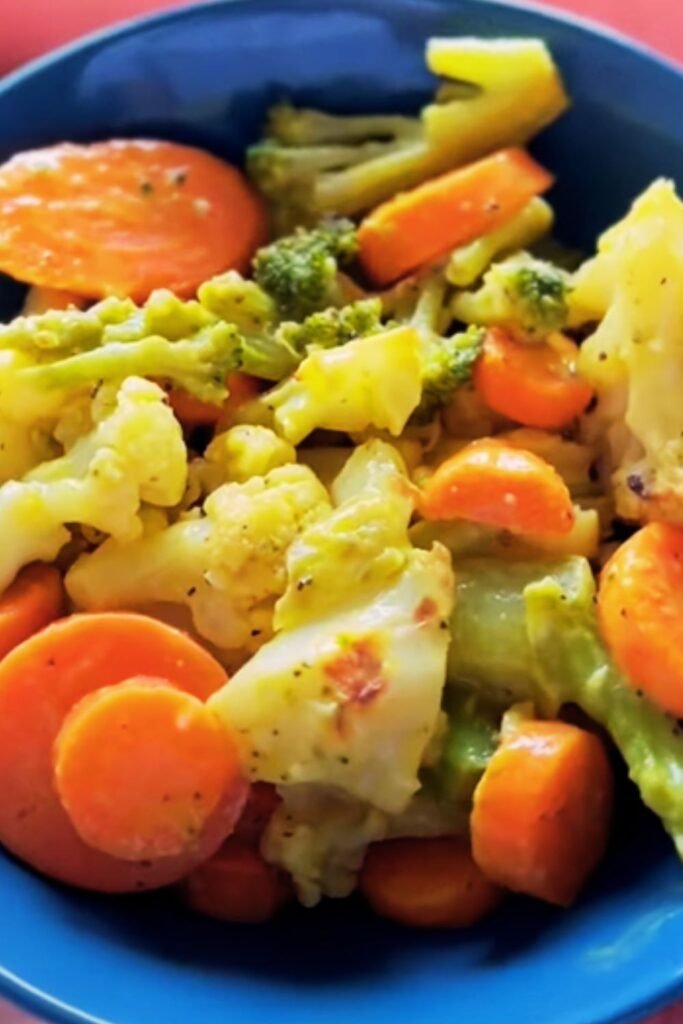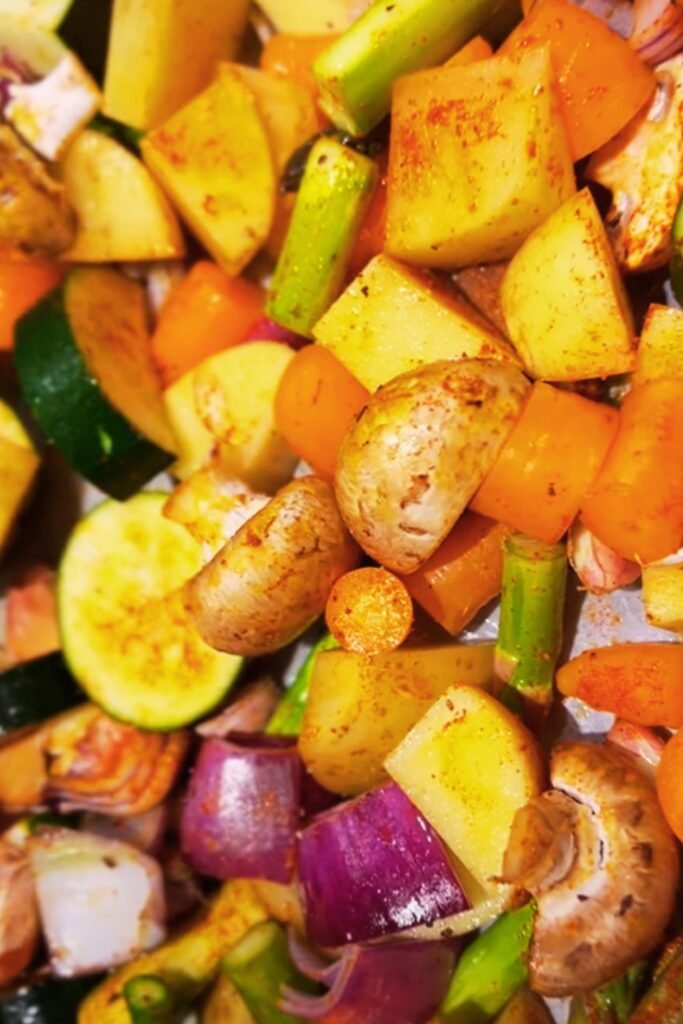There’s something magical about the transformation that happens when raw vegetables meet high heat. I’ve been perfecting my oven-roasted vegetable game for years, and I’m excited to share everything I’ve learned about turning humble produce into caramelized, flavor-packed delights using two classic cutting techniques: cubes and juliennes.
These simple cutting methods might seem basic, but they’re foundational to getting consistently perfect roasted vegetables every time. Whether you’re meal prepping for the week ahead or throwing together a quick side dish for dinner, mastering these techniques will elevate your vegetable game to restaurant quality.
Why Roasting Works Wonders
Before diving into the specifics of cutting techniques, let’s talk about why roasting vegetables works so beautifully. When vegetables are exposed to high, dry heat in the oven, several magical things happen simultaneously:
- Caramelization: The natural sugars in vegetables brown and create complex flavors
- Moisture Reduction: Water evaporates, concentrating flavors and improving texture
- Maillard Reaction: This chemical reaction between amino acids and sugars creates hundreds of new flavor compounds
- Oil Infusion: Fats carry flavors and create delightful crispy edges
The end result? Vegetables with intensified sweetness, delicious crispy edges, and tender centers. Nothing like their raw counterparts or their sadly soggy steamed cousins.
The Art of Cutting: Cubes vs. Juliennes
How you cut your vegetables dramatically affects how they cook. Let’s explore the two techniques we’re focusing on:
Cubes: The Versatile Classic
Cube cuts (sometimes called dice) involve cutting vegetables into roughly equal-sized square or rectangular pieces. Depending on the vegetable and recipe, these can range from tiny 1/4-inch pieces to chunky 1-inch cubes.
Benefits of cube cuts:
- Even cooking due to uniform size
- Versatile for almost any vegetable
- Substantial bite and mouthfeel
- Holds shape well during roasting
- Perfect for hearty dishes and meal prep
Best vegetables for cube cuts:
- Root vegetables (potatoes, carrots, beets)
- Winter squash varieties
- Eggplant
- Bell peppers
- Onions
- Zucchini and summer squash
Juliennes: The Elegant Alternative
Julienne cuts (also called matchsticks) are thin, delicate strips typically about 1/8 inch wide and 1-2 inches long. This technique creates more surface area and results in vegetables that cook quickly with maximum caramelization.
Benefits of julienne cuts:
- Quick cooking time
- Maximum surface area for caramelization
- Elegant presentation
- Crispy texture
- Perfect for tender-crisp results
Best vegetables for julienne cuts:
- Carrots
- Parsnips
- Zucchini
- Bell peppers
- Celery root
- Firm vegetables that can hold their shape
Essential Tools for Perfect Cuts
Having the right tools makes all the difference when prepping vegetables. Here’s what I consider essential:

Must-have tools:
- Chef’s knife: An 8-inch chef’s knife is your best friend for most vegetable cutting
- Cutting board: A sturdy wood or plastic board that won’t slip
- Vegetable peeler: For removing tough skins before cutting
- Mandoline: Optional but helpful for consistent juliennes (use with extreme caution!)
My tip: Invest in knife sharpening! A sharp knife is actually safer and makes prep work infinitely easier.
Master Cutting Techniques
Let’s break down exactly how to achieve perfect cubes and juliennes:
How to Cut Perfect Cubes
- Start with a flat surface: Trim off one side of the vegetable to create a stable base
- Create planks: Cut the vegetable into even slices of your desired thickness
- Stack and slice: Stack the planks and cut them into strips of equal width
- Rotate and chop: Turn the strips 90 degrees and cut across to create uniform cubes
Pro tip: For hard vegetables like butternut squash, use a heavy chef’s knife and take your time. Safety first!
How to Cut Perfect Juliennes
- Create a rectangle: Trim the vegetable into a rectangular shape
- Slice thinly: Cut the vegetable lengthwise into thin, even slices (about 1/8 inch)
- Stack and slice: Stack several slices and cut lengthwise into thin matchsticks
- Keep them dry: Pat julienned vegetables dry before seasoning and roasting
Pro tip: For consistent juliennes, consider using a mandoline with a julienne attachment, but always use the hand guard!
The Perfect Roasting Formula
After years of trial and error, I’ve developed a foolproof formula for perfectly roasted vegetables every time:
The Universal Roasting Method
- Preheat thoroughly: Always start with a fully preheated oven (425°F/220°C is my sweet spot)
- Use the right pan: Choose rimmed baking sheets for cubes; sheet pans work best for juliennes
- Don’t overcrowd: Vegetables need space to release moisture and caramelize
- Oil wisely: Use enough oil to coat but not drown (about 1-2 tablespoons per pound)
- Season generously: Salt brings out flavors (add herbs after roasting)
- Toss halfway: For even browning, toss vegetables halfway through cooking
Time and Temperature Guide
Different vegetables and cutting styles require different cooking times. Here’s my tested guide:
| Vegetable | Cut Style | Temperature | Time (minutes) | Special Notes |
|---|---|---|---|---|
| Potatoes | 1-inch cubes | 425°F | 30-35 | Parboil for 5 minutes for extra crispiness |
| Sweet Potatoes | 1-inch cubes | 425°F | 25-30 | Watch carefully as they can burn due to high sugar content |
| Carrots | 1/2-inch cubes | 425°F | 25-30 | Add honey in last 5 minutes for glaze |
| Carrots | Juliennes | 425°F | 15-20 | Great with cumin and coriander |
| Parsnips | 1/2-inch cubes | 425°F | 25-30 | Can turn quickly from caramelized to burnt |
| Parsnips | Juliennes | 425°F | 15-20 | Delicious with maple syrup drizzle |
| Bell Peppers | 1-inch cubes | 425°F | 20-25 | Remove seeds and white membranes |
| Bell Peppers | Juliennes | 425°F | 12-15 | Perfect for fajitas |
| Zucchini | 1/2-inch cubes | 425°F | 15-20 | Do not overcook or they’ll get mushy |
| Zucchini | Juliennes | 425°F | 10-12 | Keep an eye on them – they cook quickly! |
| Eggplant | 1-inch cubes | 425°F | 25-30 | Salt and drain for 30 minutes before roasting |
| Onions | 1-inch cubes | 425°F | 25-30 | Keep root end intact for easier cutting |
| Brussels Sprouts | Halved | 425°F | 20-25 | Place cut-side down for best caramelization |
| Butternut Squash | 1-inch cubes | 425°F | 30-35 | Great with cinnamon and nutmeg |
| Cauliflower | Florets | 425°F | 25-30 | Add garlic in the last 10 minutes to prevent burning |
Oil Selection: Making the Right Choice
The oil you choose impacts both flavor and cooking performance. Here are my top picks:
- Extra virgin olive oil: My everyday go-to for Mediterranean flavor profiles
- Avocado oil: High smoke point makes it perfect for high-heat roasting
- Coconut oil: Adds lovely tropical notes to sweet vegetables
- Sesame oil: Use sparingly (mixed with a neutral oil) for Asian-inspired dishes
Pro tip: For delicate vegetables cut into juliennes, consider using an oil sprayer for the lightest possible coating.
Seasoning Strategies
The beauty of roasted vegetables lies in their versatility. Here are some of my favorite seasoning combinations:
Basic Everyday Blend
- 1 tablespoon olive oil per pound of vegetables
- 1 teaspoon kosher salt
- 1/2 teaspoon freshly ground black pepper
- 2 cloves minced garlic (add halfway through cooking)
Mediterranean Magic
- Olive oil base
- Dried oregano and thyme
- Lemon zest (add after roasting)
- Crumbled feta (add after roasting)
Spicy Southwest
- Avocado oil base
- Cumin, chili powder, and smoked paprika
- Lime juice (add after roasting)
- Chopped fresh cilantro (add after roasting)
Asian-Inspired
- Sesame oil blend (1 part sesame to 3 parts neutral oil)
- Ginger and garlic (add halfway through roasting)
- Soy sauce drizzle (last 5 minutes of cooking)
- Sesame seeds and sliced green onions (add after roasting)

Troubleshooting Common Roasting Problems
Even experienced cooks encounter issues when roasting vegetables. Here’s how I solve the most common problems:
Problem: Vegetables are burning on the outside but raw inside
Solution: Your pieces are too large or your oven temperature is too high. Try cutting vegetables into smaller, more consistent pieces or lowering the temperature by 25°F and extending cooking time.
Problem: Vegetables are soggy, not caramelized
Solution: You’re likely overcrowding the pan. Use two baking sheets if necessary to give vegetables plenty of space. Also, make sure your oven is fully preheated before adding vegetables.
Problem: Some pieces are overcooked while others are undercooked
Solution: Your cuts aren’t uniform in size. Take more time to ensure consistent sizing, especially when mixing different vegetables.
Problem: Vegetables stick to the pan
Solution: Line your pan with parchment paper or a silicone baking mat. Alternatively, make sure you’re using enough oil and toss the vegetables halfway through cooking.
Delicious Combinations for Mixed Roasts
Some vegetables naturally complement each other in both flavor and cooking time. Here are my favorite combinations:
Fall Harvest Mix (Cubed)
- Butternut squash
- Brussels sprouts
- Red onion
- Whole garlic cloves
- Seasoned with sage and maple syrup
Mediterranean Medley (Cubed)
- Eggplant
- Zucchini
- Bell peppers
- Red onion
- Seasoned with oregano, basil, and balsamic vinegar
Root Vegetable Glory (Juliennes)
- Carrots
- Parsnips
- Sweet potatoes
- Seasoned with thyme and rosemary
Spring Delights (Julienned)
- Carrots
- Asparagus
- Yellow squash
- Seasoned with lemon zest and dill
Pro tip: When mixing vegetables, either group them by similar cooking times or add quicker-cooking vegetables to the pan partway through the roasting process.
Beyond Side Dishes: Creative Uses for Roasted Vegetables

Roasted vegetables deserve to be more than just a side dish. Here are some of my favorite ways to use them:
Grain Bowls and Salads
- Top warm farro or quinoa with roasted vegetables
- Toss cooled roasted cubes into leafy green salads
- Add julienned roasted vegetables to pasta salads
Sandwiches and Wraps
- Layer roasted vegetables with hummus in pita bread
- Add to grilled cheese sandwiches for gourmet upgrade
- Wrap julienned roasted vegetables with greens and tahini
Breakfast Options
- Add cubed roasted sweet potatoes to breakfast burritos
- Top avocado toast with julienned roasted vegetables
- Fold roasted peppers and onions into omelets
Appetizers and Snacks
- Blend roasted vegetables into hummus or dips
- Serve chilled roasted vegetables with yogurt-herb sauce
- Add to charcuterie boards for color and nutrition
Meal Prep Magic: Make Once, Eat All Week
One of the best things about roasted vegetables is their meal prep potential. Here’s my strategy:
- Sunday Prep Session: Roast 2-3 large sheet pans of mixed vegetables
- Cool Properly: Allow vegetables to cool completely before refrigerating
- Store Strategically: Keep in airtight containers for 3-5 days
- Reheating Options:
- Microwave: Quick but sacrifices texture
- Stovetop: Quickly sauté to refresh texture
- Oven: 350°F for 5-10 minutes to restore crispness
Pro tip: Keep portions of julienned vegetables separate from cubed ones, as they reheat at different rates.
Next-Level Serving Suggestions
Elevate your roasted vegetables with these finishing touches:
Sauces and Drizzles
- Balsamic glaze
- Chimichurri
- Romesco sauce
- Lemon-tahini drizzle
- Herb-infused yogurt
Crunchy Toppings
- Toasted nuts (walnuts, pine nuts, almonds)
- Roasted seeds (pumpkin, sunflower)
- Crispy shallots
- Homemade croutons
- Dukkah spice blend
Fresh Herbs
- Chopped parsley
- Chiffonade of basil
- Snipped chives
- Fresh mint leaves
- Cilantro
Environmental Considerations
As a vegetable enthusiast, I’m also mindful of making environmentally friendly choices:
- Seasonal Vegetables: Choose what’s in season for better flavor and lower carbon footprint
- Local Sources: Farmers markets offer the freshest produce with fewer transportation miles
- Root-to-Stem Cooking: Use vegetable scraps for homemade stock
- Energy Efficiency: Batch-roast multiple trays to maximize oven use
- Composting: Return vegetable scraps to the earth through composting
Frequently Asked Questions
Q: Can I roast frozen vegetables? Yes, but with modifications. Don’t thaw them first—roast directly from frozen at 450°F instead of 425°F. Expect them to release more moisture, so give them extra space on the baking sheet. They won’t caramelize quite as well as fresh, but they’ll still be delicious.
Q: Why do my vegetables shrink so much during roasting? Vegetables contain significant water that evaporates during roasting. Root vegetables typically shrink 20-25%, while water-rich vegetables like zucchini can shrink up to 40%. Always cut more than you think you’ll need!
Q: Can I roast different vegetables together on one pan? Yes, but be strategic. Either choose vegetables with similar cooking times, or add quicker-cooking vegetables to the pan later. Alternatively, cut quicker-cooking vegetables into larger pieces and longer-cooking ones into smaller pieces to help them finish at the same time.
Q: Do I need to peel vegetables before roasting? Not necessarily! Many vegetable skins become tender when roasted and contain valuable nutrients. I generally only peel when the skin is particularly tough or bitter (like winter squash or mature beets). Always wash vegetables thoroughly regardless.
Q: How do I know when my roasted vegetables are done? Look for these three signs: 1) Edges are caramelized to golden brown, 2) A fork or knife easily pierces the center, and 3) They’ve developed a concentrated aroma. Trust your senses more than strict timing.
Q: Can I make roasted vegetables ahead for a dinner party? Absolutely! Roast them until they’re almost—but not quite—done (about 5 minutes less than normal). Cool completely, refrigerate, then finish roasting at 375°F for 10 minutes just before serving. They’ll taste freshly made!
Q: What can I do if my vegetables are cooking unevenly? First, ensure your oven temperature is accurate with an oven thermometer. Then, rotate your pans halfway through cooking and give everything a good toss. For persistent hot spots, consider using an additional baking sheet on a different rack as a heat buffer.
Q: Are there any vegetables that don’t roast well? Very delicate vegetables like leafy greens aren’t ideal for traditional roasting. Watery vegetables like cucumber and celery also don’t roast well. Some vegetables that surprise people with how well they roast include radishes, cabbage wedges, and romaine hearts!
Final Thoughts
Mastering the art of roasting vegetables—whether in hearty cubes or elegant juliennes—has transformed my cooking and eating habits. The beauty of this method lies in its simplicity and versatility. With just a few foundational techniques, you can create endless variations that highlight the natural sweetness and complexity of vegetables.
Whether you’re a dedicated vegetable lover looking to expand your repertoire or someone trying to incorporate more plant-based foods into your diet, roasting is your secret weapon. The caramelized edges, tender centers, and intensified flavors make vegetables irresistible even to the most committed carnivores.
So crank up that oven, sharpen your knife, and get ready to transform humble produce into the star of your table. Your taste buds—and your body—will thank you.